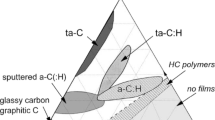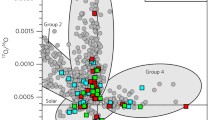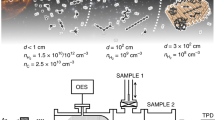Abstract
The influence of complex dust composition on the general chemical evolution of a prestellar core and the content of complex organic compounds is studied. It is shown that various component groups respond differently to the presence of a small dust population. At early stages the difference is determined primarily by changes in the balance of photo processes due to effective absorption of ultraviolet photons by small dust grains of the second population and collisional reactions with dust particles. At later stages differences are also caused by the growing dominance of additional reaction channels related to surface organic synthesis.
Similar content being viewed by others
Introduction
The surface chemistry is a very important factor in the chemical evolution of star-forming regions. The most important process that takes place on the surface of dust particles is molecularization of hydrogen. Also high observed abundances of complex species are explained by surface processes. When modeling surface processes a simplified model of dust is used: grains are assumed to be spherically symmetric, homogeneous, having the same size and temperature. But real dust particles hardly have these properties.
It poses a question: how acceptable is this simplification? Does the chemical evolution depend on the parameters of dust particles involved? We examined the acceptability of this approach in a somewhat different fashion than in Acharyya et al. (2011). In the present work we use a 1D model while Acharyya et al. (2011) utilized a 0D model. The 1D model allows us to get closer to real conditions in the cloud and to explore the interaction of dust and radiation in more detail, thus, providing more general insight onto the influence of dust on the chemistry in a cloud. Note that we do not explore the dust growth of dust, rather concentrating on finding out what features related to the presence of small grains cause the greatest differences.
Model
In this paper we used the Presta model (Wiebe et al. 1996; Shematovich et al. 1999; Kochina et al. 2013), which is a multi-point model of the chemical evolution of a spherically symmetric cloud with a central source of radiation that is also illuminated by an external radiation field. All the main chemical processes are taken into account. Basic chemical reactions are taken from UDFA 2006 (Woodall et al. 2007).
The version of a model we used is based on the one presented in Kochina et al. (2013). The main modification of the model is that in its presented version it works with several populations of dust. This paper presents results of the simulation with only two dust populations included: large and small dust particles (model MD). The influence of complex dust composition on the general chemical evolution of a prestellar core and the content of complex organic compounds is studied. Physical parameters of various dust populations are presented in Table 1.
Temperatures for different dust populations were calculated using a radiative transfer model that takes into account stochastic heating of dust particles of different sizes and chemical compositions (Pavlyuchenkov et al. 2012) illuminated by external and internal radiation fields. Temperature profiles are shown in Fig. 1. The gas temperature is assumed to be equal to the temperature of large dust particles.
The work was focused on assessing the impact of different sizes and temperatures of dust particles on the chemical evolution, so a number of factors, such as the evolution of the cloud physical structure, as well as growth and destruction of dust particles were not considered. In order to compare the model with a standard one, a model with a single classical population of dust (model D), with parameters of dust corresponding to the first column of Table 1 with the mass fraction of 1 was calculated.
Results and Discussion
Four qualitative changes come with the population of small dust particles. Firstly: increasing the total grain surface area per unit volume increases the number of sites available for surface reactions. Secondly, due to adding a large number of small particles the total number of dust grains increases. Thirdly, the difference in temperatures between large and small dust particles leads to differences in rates and channels of surface reactions. Fourthly, characteristics of UV radiation absorption change, while UV field is a key factor for a number of chemical reactions in cloud regions exposed to external and internal radiation.
The study showed that one third of all components is insensitive to details of the dust composition. Their column densities in the considered models differ from each other less than by a factor of three during the whole evolutionary time span. The components that are sensitive to dust properties happen to show different responses. Below we consider the impact of changes in dust properties on abundance evolution of some astrobiologically relevant complex organic species. The abundance evolution of the species mentioned below is shown in Fig. 2.
Abundance evolution of some astrobiologically relevant complex organic species. Note: The sharp variations in the plots of Fig. 2 appear due to large time steps used and the adoption of a logarithmic axis scaling
C2H - content of the molecule in the gas phase hardly changed. This is because the main reactions in which the molecule is involved are photoreactions induced by cosmic rays. The presence of small particles does not affect the rates of these reactions, so inclusion of these particles does not affect main channels of C2H production and destruction. Differences in abundances appear only at later times, when differences in abundances of other, more sensitive species, participating in reactions with C2H, begin to show up.
CH3OH - the difference in gas phase abundances between models D and MD is considerable and exceeds an order of magnitude through all the considered period of chemical evolution. Maximum differences (more than two orders of magnitude) are archived in 5000 years since the beginning of the chemical evolution. Since that time, the difference gradually decreases and reduces down to one order of magnitude and smaller. This happens because of increasing accretion onto dust particles, especially those of the second population. As to the abundance of the species on the dust surface, the one on the dust particles on the first population in model MD is lower than in model D, but the total surface abundance of the species model MD at later times exceeds that in model D by more than four orders of magnitude. The reason is in the greater rates of methanol production on the dust particles of the second kind and its accumulation of them. The only process that reduces the surface content of methanol molecules is desorption. Desorption rate increases and reduces the difference in gas phase abundances between models MD and D-model sat later times.
H2CO – the evolutionary scenarios for gas phase abundances of this molecule are somewhat different in models D and MD. In model MD abundance decreases monotonically, while in model D the initial period is marked with the increase of abundance, but then it decreases, even more drastically than in model MD, and later increases again. During almost the entire evolutionary time, formaldehyde abundance is much lower in model MD. At early (about 500 years) and later times difference exceeds one order of magnitude. Only for a short period of time abundances are nearly the same in both models (being actually even slightly greater in model MD). The evolutionary scenario of this molecule surface abundance is also interesting. At early times scenarios in both models are, in general, identical. However, starting from the chemical age of 50,000 years, the H2CO abundance on the grains of the first population in model MD begins to increase sharply, while in model D it stays the same and increases slightly only during a small period of time. The difference between the abundances exceeds five orders of magnitude. The abundance on the grains of the second population in model MD exceeds that on dust in model D during the entire time interval. The difference in the abundances of H2CO arises due to a change in the balance of surface reactions, caused by the presence of the second dust population. Due to a great number of participating molecules (O, CH2, CH, OH) accreted on small grains, rapid reactions of production start to overcome reactions of destruction and cause the fast growth of the H2CO abundance on surfaces of small grains.
HCOOH - the evolutionary scenario of this molecule’s abundance is very interesting. As for the dust components, the scenarios are very similar. The total surface abundance in model MD is almost equal to that in model D. But the differences in the evolutionary scenarios for gas phase abundances are very curious. Going in the opposite ways initially, at later times they start to converge. Abundance in model D initially increases, reaching a maximum at 500–1000 years of the chemical age. The abundance in model MD decreases and reaches a minimum at the same time. Difference reaches 2.5 orders of magnitude. Analysis of radial profiles shows that the difference in the scenarios is caused by persistent drop of HCOOH abundance in model D in the cloud regions exposed to ultraviolet field from the protostar (inner region) or interstellar radiation (outer region). Ultraviolet photons are effectively shielded by small dust particles in model MD and are significantly less shielded in model D. They easily penetrate the cloud and destroy HCOOH molecules. The most effective channel of its destruction in model MD is the interaction with CR-induced photons. And it is seven orders of magnitude less efficient than the destruction by UV photons. Thus, in this case small dust particles are a shield that protects the molecules.
Conclusions
The presented results indicate that the inclusion of the second dust grain population has a strong effect on the protostellar chemical evolution. The small dust particles lead to a number of effects, the influence of which is different for different components. The main result of the work is finding out that on early stages the difference is determined primarily by changes in the balance of photo processes due to effective absorption of ultraviolet photons by dust grains of the second population and collisional reactions with dust particles. Surface chemistry does not play any significant role here. Most important is the number of grains, not their parameters. But at later stages differences are caused by the growing dominance of additional reaction channels related to surface organic synthesis.
References
Acharyya K, Hassel GE, Herbst E (2011) The effects of grain size and grain growth on the chemical evolution of cold dense clouds. Astrophys J 732:73
Kochina OV, Wiebe DS, Kalenskii SV, Vasyunin AI (2013) Modeling of the formation of complex molecules in protostellar objects. Astronomy Reports 57:818
Pavlyuchenkov YN, Wiebe DS, Akimkin VV, Khramtsova MS, Henning T (2012) Stochastic grain heating and mid-infrared emission in protostellar cores. Monthly Not Roy Astron Soc 2430:421
Shematovich VI, Wiebe DS, Shustov BM (1999) Chemical and dynamical evolution of protostellar clouds: chemistry at early stages of collapse. Astronomy Reports 43:645
Wiebe D, Shematovich V, Shustov BM (1996) Chemical and dynamical evolution of protostellar clouds: initial stages of collapse. Astronomy Reports 40:639
Woodall J, Agundez M, Markwick-Kemper AJ, Millar TJ (2007) The UMIST database for astrochemistry. Astron Astrophys 466:1197
Acknowledgments
This work has been supported by the RFBR grant 13-02-00642.
Author information
Authors and Affiliations
Corresponding author
Rights and permissions
About this article
Cite this article
Kochina, O., Wiebe, D. Organic Compounds in Star Forming Regions. Orig Life Evol Biosph 44, 169–174 (2014). https://doi.org/10.1007/s11084-014-9378-1
Received:
Accepted:
Published:
Issue Date:
DOI: https://doi.org/10.1007/s11084-014-9378-1






